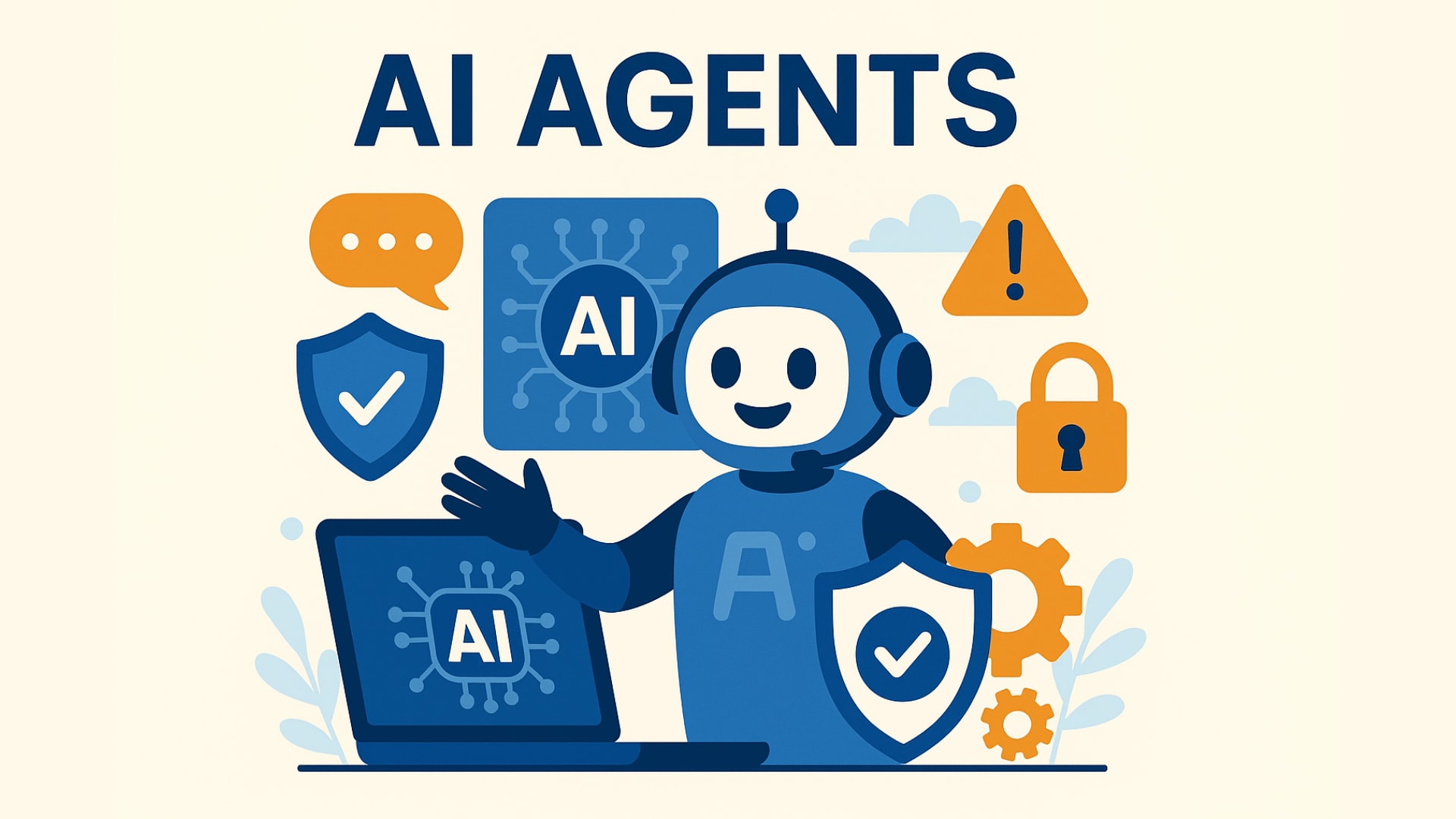
Imagine a digital guardian that never sleeps, learns from every attack and adapts faster than any human ever could. This is the vision behind AI agents in cybersecurity — autonomous, intelligent systems designed to transform cyber defense from a reactive task into a proactive strategy.
AI has many forms, but when we focus specifically on AI agents, we begin to see their unique potential in cybersecurity workflows. Unlike static algorithms, AI agents are built to act independently, making real-time decisions based on a continuous stream of data.
Table of contents
Defining an AI Agent
An AI agent can be described as a self-governing program or system that performs tasks on behalf of a user or another system. These agents aren’t just executing pre-written instructions; they design workflows, assess environments and make decisions to achieve goals.
While basic agents follow fixed rules, advanced ones exhibit autonomy. They interpret context, analyze inputs and take action without constant human oversight. These rational agents optimize their actions based on their observations, learning from experience to improve over time. More sophisticated agentic AI can set its own sub-goals to accomplish broader objectives, adapting to new challenges with minimal input.
How AI Agents Work in Cybersecurity
In cybersecurity, AI agents serve as autonomous defenders. They monitor networks, analyze user behavior, detect anomalies and respond to potential threats—often faster and more accurately than humans can.
One of their primary tasks is pattern recognition. Machine learning enables these agents to sift through immense volumes of data and identify the subtle indicators of a threat. Behavioral analytics adds another layer, helping them distinguish between normal and suspicious user behavior. Together, these capabilities allow AI agents to detect, investigate and even respond to threats in real time.
Consider the daily reality for security teams: thousands of alerts pouring in from various systems. Analysts may only have time to examine a fraction of these, leaving potential threats unchecked. AI agents reduce this burden by filtering irrelevant alerts and highlighting the most critical ones. They can manage triage, conduct adaptive threat hunting and even initiate automatic responses to contain or neutralize attacks.
In application security, AI agents can go further—automating code analysis, generating penetration tests and even suggesting or implementing fixes for detected vulnerabilities. This shifts security from being reactive to truly integrated throughout the software development lifecycle.
Real-World Use Cases
E-commerce Fraud Detection
Retail platforms use AI agents to flag suspicious transactions in real time. The agent might analyze factors like mismatched billing/shipping addresses, unusual cart behavior, or rapid-fire purchases using multiple credit cards. Unlike static fraud filters, AI agents adapt to new fraud patterns as they emerge.
Security Operations Centers (SOC)
In security operations, agents act as digital analysts. They filter thousands of alerts each day, help prioritize true threats and automate responses. When paired with human analysts, they help reduce alert fatigue and improve response time across large organizations.
Application Security
In AppSec environments, AI agents help scan new code for vulnerabilities, automate dynamic application security testing (DAST) and even simulate attacks. They can also suggest remediations — like code changes or configuration fixes—reducing risk at the development stage.
Bot Mitigation and Verification
Websites face daily attacks from automated bots — scraping content, trying credential stuffing, or launching DDoS attempts. AI agents can identify these bots by analyzing interaction patterns and blocking them before they do damage. They work particularly well when combined with front-end defenses, like captcha.eu, which filters out malicious bots while remaining accessible and privacy-compliant for real users.
Benefits of AI Agents in Cybersecurity
AI agents offer numerous benefits that make them indispensable in modern cybersecurity strategies. First and foremost, they bring speed and scale. They operate around the clock, continuously analyzing and responding without fatigue. They also reduce mean time to detection (MTTD) and mean time to response (MTTR), two key metrics in effective threat management.
Another critical advantage is their role in reducing alert fatigue. By filtering noise and prioritizing threats, AI agents free up human analysts to focus on higher-level strategy and complex investigations. This not only improves incident response, but also contributes to analyst well-being and retention.
Finally, AI agents help organizations stay agile. As threat actors evolve their tactics, so too can intelligent agents—learning from new data and adapting defenses in real time.
Challenges and Considerations
Despite their potential, implementing AI agents is not without challenges. One major concern is accountability. When an AI system acts incorrectly, who is responsible? As these systems become more autonomous, ensuring proper oversight becomes more complex.
Bias in AI models is another issue. Agents trained on historical data can inherit problematic assumptions or unfair prioritizations. This can result in false positives or disproportionate scrutiny of certain users.
Transparency is also a concern. Many AI models operate as “black boxes,” making it hard to explain why a certain decision was made. For security teams, this lack of interpretability can lead to mistrust and slow response times.
Technically, integrating AI agents into existing infrastructures requires high-quality data, skilled personnel and sufficient computing resources. These systems themselves can become high-value targets, requiring robust defenses to prevent compromise.
And while AI agents can handle many routine tasks, they still need human supervision. Critical decisions, ethical considerations and nuanced understanding of business context all remain in the human domain. Over-reliance on automation can lead to complacency and blind spots.
Moreover, attackers are also beginning to use AI. Offensive agentic AI could launch adaptive, autonomous attacks, forcing defenders to match sophistication and speed with equally advanced tools.
Future of AI and Human Collaboration
Looking to the future, AI agents will play a growing role in cybersecurity, from detecting zero-day threats to orchestrating comprehensive responses across networks. Yet, their success will depend on how well organizations balance automation with human oversight.
The ideal approach combines the efficiency and scale of AI agents with the judgment and creativity of human analysts. AI should augment human capabilities, not replace them. This partnership enables faster detection, smarter responses and a more resilient defense posture.
Organizations adopting AI agents must also invest in governance: ensuring models are explainable, biases are addressed and systems are transparent and secure. This requires clear policies, continuous monitoring and cross-functional collaboration among security, compliance and AI ethics teams.
Conclusion
AI agents are transforming how we defend digital infrastructure. These intelligent systems can spot threats, respond faster than humans and adapt as attacks evolve. But they are not a plug-and-play solution. Their effective use requires thoughtful integration, careful monitoring and an ethical framework that includes transparency, accountability and fairness.
Used wisely, AI agents offer a powerful new tool for protecting organizations from the growing tide of cyber threats. Combined with human expertise and privacy-first tools, like captcha.eu — which provides secure, accessible protection against bots and abuse—they form a layered, modern defense strategy ready for the challenges ahead.
FAQ – Frequently Asked Questions
What is an AI agent in cybersecurity?
An AI agent in cybersecurity is an autonomous software system that can monitor digital environments, detect threats, and take action — often without human intervention. It uses artificial intelligence techniques like machine learning and behavioral analytics to adapt and respond to evolving security challenges.
How are AI agents different from traditional cybersecurity tools?
Traditional tools rely on static rules and predefined responses. AI agents, on the other hand, learn from data, adapt to new threats and make decisions dynamically. They’re designed to operate independently and improve over time, offering a more proactive and scalable defense.
What kind of threats can AI agents detect?
AI agents can identify a wide range of threats, including malware infections, phishing attempts, insider threats, bot activity, unauthorized access, and anomalous user behavior. Their ability to analyze large datasets allows them to detect both known and emerging threats.
Are AI agents replacing human cybersecurity professionals?
Not at all. AI agents are designed to assist, not replace, human analysts. They handle repetitive tasks, prioritize alerts, and reduce response time, allowing human teams to focus on strategic decision-making and complex investigations.
How do AI agents handle bots?
AI agents can detect bot activity by analyzing behavior patterns that deviate from human norms — such as rapid navigation, form submissions or unusual login attempts. To prevent bots from entering a system in the first place, they work well in tandem with bot mitigation solutions like captcha.eu, which distinguishes between humans and bots using privacy-compliant, accessible methods.
100 free requests
You have the opportunity to test and try our product with 100 free requests.
If you have any questions
Contact us
Our support team is available to assist you.




